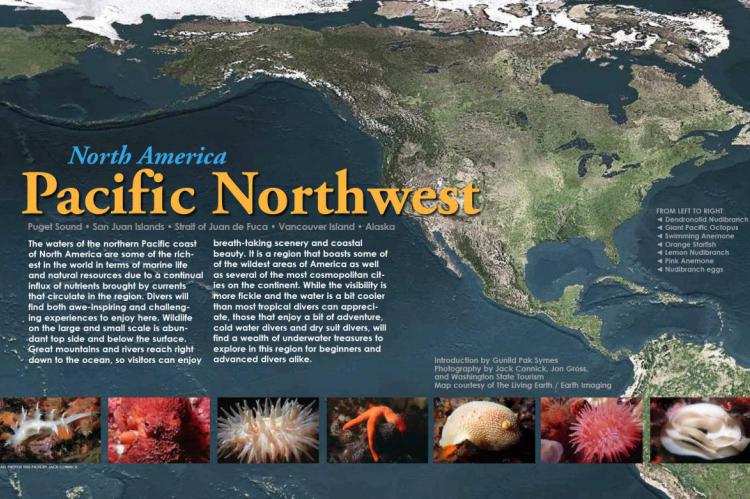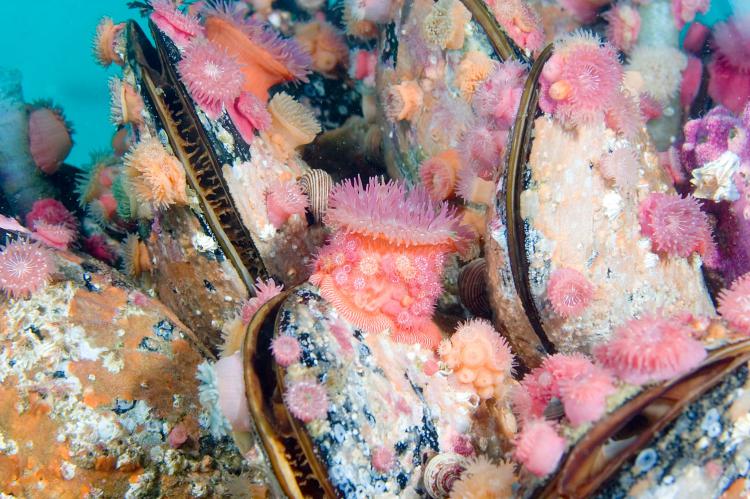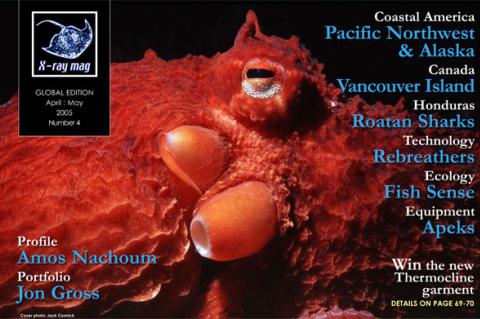North America's 'Pacific Northwest'
Puget Sound • San Juan Islands • Strait of Juan de Fuca • Vancouver Island • Alaska.
The waters of the northern Pacific coast of North America are some of the richest in the world in terms of marine life and natural resources due to a continual influx of nutrients brought by currents that circulate in the region. Divers will find both awe-inspiring and challenging experiences to enjoy here.
Tags & Taxonomy
Picking the right dive site at the right time of year and the right time of day with the right dive operator, those of us who are avid underwater photographers can capture some fantastic images on film. The people who live in the Pacific Northwest are friendly and casual, helpful folk. Neighborhood operators, who know the region like the back of their hands because they dive these sights for personal enjoyment weekly, are very happy to help newcomers enjoy the riches of the underwater realm found practically in their backyards.
The complete scope of diving in the Pacific Northwest cannot be covered in one article alone, however, highlights of both well known dive sites and lesser known sites can be provided here for curious dive travellers who are yearning to explore the Wild West.
We start in the Puget Sound, the sea of emerald islands located in the northwest corner of the state of Washington, where the cities of Seattle and Tacoma border the lower and upper sound. Getting the inside scoop from local dive charter operator, Mike Ferguson of Porthole Dive Charters, readers will learn about the numerous places to dive and observe marine life, such as Orca whales, close to the cities and out among the gentle islands.
We, then, head north to the Strait of Juan de Fuca, Neah Bay and Cape Flattery at the most western point of the contiguous United States where the Makah Nation, the Native American tribe indigenous to the region, make their home. Local diver and member of Marker Buoy Dive Club, the largest dive club in Seattle, Jack Connick, gives us a bird’s eye view of the lesser known dive spots in the area.
Continuing northwords, our correspondent, Jon Collins, explores the amazing diving in and around Vancouver Island in British Columbia, Canada, a fascinating place with a complex history that blends European, American and native cultures, nestled in a magestic natural setting.
Finally, we head up to Alaska, where correspondent, Barb Roy, shares her dive adventure in Prince William Sound and points along the southern Alaskan coast. A land of dramatic extremes, Alaska provides the visitor with a taste of how the planet was in its most pristine state. There, the midnight sun and the Northern Lights are a constant backdrop to the wilderness and remote cities that dot the southern coast of this region, which reaches up into the Arctic circle.
Puget Sound
For folks in Seattle and Tacoma, the Puget Sound is a neighborhood playground for divers, snorklers, hikers, whale watchers, anglers, kayakers and other outdoor enthusiasts. Because of the nutrient rich currents, the sound is abundant with sea life. Residents in the cities regularly spend time during the work week and weekends enjoying this beautiful area. What follows are a few high points regarding the incredible diving to be found so close to an urban area.
Although the northern end of the Puget Sound is known for several outstanding dive sites, south and central Puget Sound also has a good number of interesting sites with diverse and abundant sea life.
Local divers including Jon Gross and Keith Clements, authors of a comprehensive online guide to over 45 sites in the Puget Sound, The Marine Life Index at seaotter.com, dive these areas regularly. They point to Point Defiance as one of the favorites. There is a massive shear wall at this site to explore. However, due to depth and currents, it is considered an advanced dive site. The recommended approach is to dive the West Wall on the flooding tide and then the North Wall in the ebbing tide.
The terrain of this site is uneven and full of life. Giant Pacific Octopus, Mosshead Wabonnets and Grunt Sculpins can be found here. Divers can also find Wolf-eel, Striped Sea Perch, Red Irish Lords, Buffalo Sculpins, Brown Rockfish, Ratfish and Painted Greenlings. Orange Sunflower Stars add brilliant color to the seascape. Point Defiance is a popular fishing spot, so divers should be careful of old fishing sinkers, lures and line lying on the seafloor as well as the boat traffic.
Shore Dives
There are popular shore dives in the southern and central sections of the Puget Sound including Three Tree Point, which holds diverse marine life in a “junk yard” reef and eel grass beds—on rare occasions there may be a six gill shark looming here; Titlow Beach, a good place to check out sea life among pilings; Deadman Wall where you may have a rare encounter with eel-like creatures called Red Brotulas; Seahurst Park, a subtle site that is noted for being a fine place to find various large nudibranchs and sea pens; Les Davis Reef where you can find huge schools of perch; and Sunrise Beach, known for friendly Wolf-eels and large-sized Giant Pacific Octopus.
Edmonds Underwater Park
Edmonds Underwater Park is an artificial reef developed in the harbor of Edmonds by a few heroic members of the community who took interest in marine conservation and diversity. Edmonds is a quaint little northwestern town of small cafés and boutiques on a gentle slope leaning down to the coast a few miles north of Seattle. It is probably the best-known dive location in the state.
The dive park is located just north of the ferry landing at Edmonds. It offers terrific diving for several reasons. At this site, the depths are shallow and there is an absense of strong currents, the beaches are well kept and scenic, the facilities are very good and include showers, there is easy parking, lots of different places to grab a bite to eat between dives, a well-equipped dive shop nearby called Underwater Sports, and close proximity to Seattle.
The marine life here is in unique condition and serves as a testament to how it can bounce back if people give it a chance. The dive park is a favorite for beginning divers as it has a whole lot to see in easy dives. The reef is an extensive organized hodge-podge of attractions marked by buoys including an old dry dock, wooden boats including a tugboat “The Triumph”, tire collections, concrete blocks, rock piles, wire hoops and other materials. It is also a site with a large number of enormous Lingcod that grow up to 4 or 5 feet long (1-2 m). Other species include Cabezon, Quillback and Copper Rockfish, Plumose Anemones, Pile Perch, Striped Sea Perch, Shiner Perch, gunnels, Sailfin Sculpines, Rock Soles, some Red Irish Lords, Ratfish, lots of shrimp, crabs and massive Sunflower Stars.
Waterman’s Wall
Considered one of the best wall dives in the state, Waterman’s wall is located in the Port Orchard area, just south of Bainbridge Island.
The terrain consists of shear faced walls, long ledges, rock piles and ...
Download the full article ⬇︎































